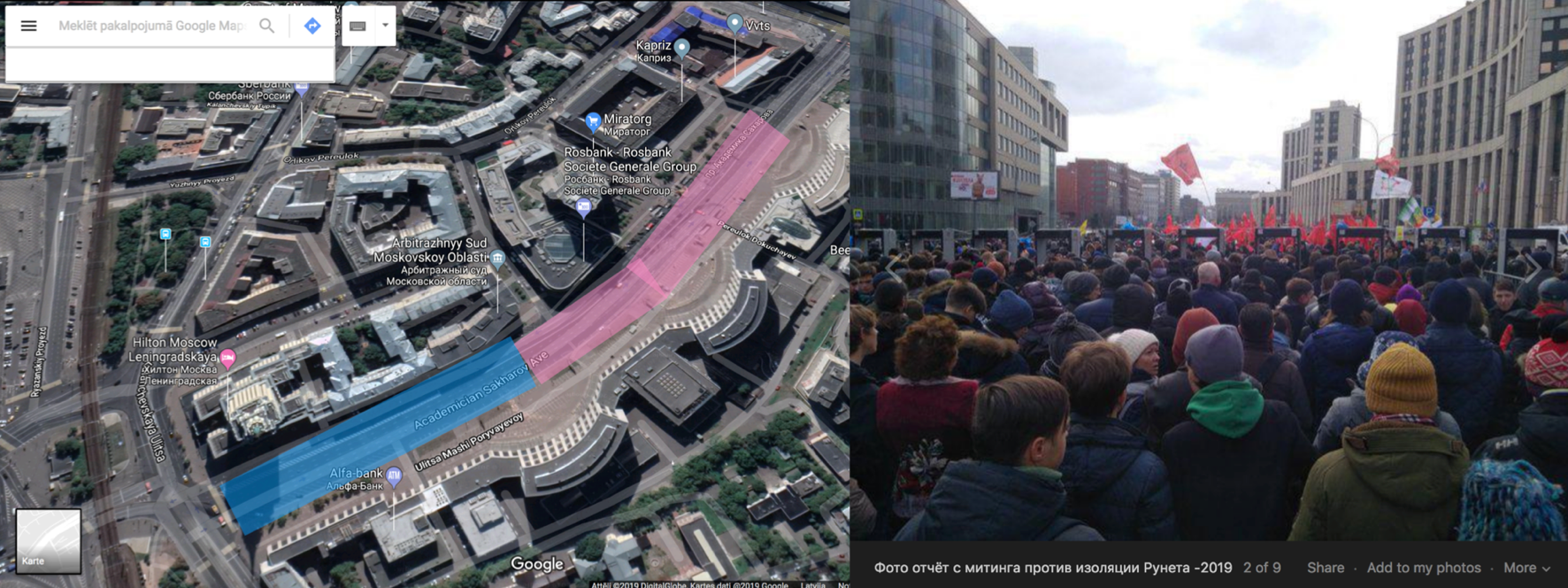#DigitalResilience: Russians Demonstrate Against Digital Isolation Law
Assessing the crowd size for Russia’s internet freedom protest in Moscow
#DigitalResilience: Russians Demonstrate Against Digital Isolation Law

Assessing the crowd size for Russia’s internet freedom protest in Moscow

An estimated 12,000 people attended a demonstration to secure internet freedom organized by Russia’s Libertarian Party in Moscow on March 10, 2019, the DFRLab has calculated. This estimate is lower than the 15,300 figure provided by White Counter, a nonpartisan group of volunteers who count people that passed police checkpoints, and nearly double the 6,500 figure that Russia’s Ministry of Interior provided based on Moscow police data.
While analyses of crowd numbers are complex under any circumstances, this analysis suggests that Russian authorities understated the turnout, while the organizers overstated it, although to a lesser degree.
The demonstrators were protesting the proposed “sovereign internet” legislation that passed the Russian Parliament’s first reading on February 13, 2019. The law aims to establish a legal framework for creating a centralized system for controlling internet traffic in Russia. Although the legislation’s authors’ stated reason for creating the “sovereign internet” law was to protect Russia’s internet from an external cyberattack, the protesters believed the law’s ulterior purpose was to isolate Russian internet users from the World Wide Web and censor online information.
A similar demonstration happened on April 30, 2018, after Russian authorities tried to ban Telegram, an encrypted messenger app. Demonstrators gathered in Moscow to show support for a “digital resistance” movement initiated by Pavel Durov, the founder of Telegram and VKontakte, a popular social-media platform in the Russian-speaking world. White Counter claimed that 12,500 people attended the demonstration, while Russia’s Ministry of Interior said there were only 7,500 attendees.
Geolocation of the Demonstration Area
The DFRLab used verified open-source images from the demonstration to calculate the approximate number of participants.
Independent Russian media outlets Meduza.io and Novaya Gazeta reported delays in the processing of demonstrators at the police checkpoints. These delays effectively created two adjacent areas at which demonstrators gathered — a demonstration zone for those demonstrators that had passed the police checkpoints and a waiting area for those who had not yet cleared the checkpoints.
The police checkpoints were placed near the Domnikov business center at the intersection of Arhitektora Rochegova and Akademika Sakharov Avenues.

The outer edge of the area designated for the demonstration was one block away from the intersection of Akademika Sakharov Avenue and Sadovaya-Spasskaya Street.

It is hard to estimate where the crowd waiting to enter the demonstration zone ends, but it is safe to assess that it continues at least until the intersection of Akademika Sakharov Avenue and Kalanchevskaya Street.


Assessing Density
The density of demonstrators varied within the flagged areas over time. According to YouTube metadata view tool YouTube Data Viewer, YouTube blog Drugoe Mnenie (“Different Opinion,” translated from Russian) published a roughly three-hour live video on Sunday, March 10, 2019, between 2:10 p.m. and 5:11 p.m., Moscow time. The DFRLab took screenshots from the video showing the density of people at different times.

The DFRLab identified two drone photos showing the density of demonstrators within the designated protest area. The date of the posts — March 10, 2019 — makes it highly likely it is showing the demonstration for the internet freedom in Moscow.

The DFRLab also identified four photos taken from a camera attached to a drone that provided a bird’s-eye view of the crowd of demonstrators in the waiting zone around the police checkpoints to get into the protest area.

The DFRLab estimated the crowd-size gathered around the police checkpoints in the waiting zone, which — from the images and video footage used in this analysis — was where the crowd appeared to be most dense. Crowd-size measurement is difficult even under ideal conditions, as there is a tendency to overcount, so all figures should be calculated conservatively. According to First in Architecture, a recognized online resource for the architectural community, the average shoulder width is 0.395 meters for women and 0.465 meters for men. These figures suggest that four people can fit into a square meter with shoulders barely touching.
The DFRLab’s approximate assessment of the maximum density of the crowds waiting at the police checkpoints was 1.5 person per square meter, based on a visual analysis of the drone image. This estimate suggests that individuals in the crowd would have been, on average, one arm’s length from one another. According to the crowd geographical density verification tool Mapchecking.com, the area of the waiting zone was 8,256.31 square meters, which, at a density of 1.5 people per square meter, would equate to a maximum of 12,384 people within the waiting zone.
8,256.31 sq meters / 1.5 people per sq meter = 12,384 people

Mapchecker.com does not provide a margin of error for its calculation, so its results should be taken as indicative rather than definitive. If we assume a margin of error of 25 percent, the total number of demonstrators waiting before or at the police checkpoints would be between 9,000 and 15,000. Assuming that all of individuals waiting at the checkpoint attended the demonstration, the upper margin of that estimate just barely reaches the figure provided by White Counter, while the lower margin is still substantially higher than the figure cited by Moscow authorities.
Conclusion
This analysis is indicative rather than conclusive, as it is based on an estimated crowd density and a geolocated demonstration area. Nevertheless, it suggests that White Counter may have overstated the attendance of the Moscow internet freedom demonstration to some degree, while Moscow authorities significantly understated it. The DFRLab estimation is that approximately 12,384 people made it into the designated demonstration area.
Register for the DFRLab’s upcoming 360/OS summit, to be held in London on June 20–21. Join us for two days of interactive sessions and join a growing network of #DigitalSherlocks fighting for facts worldwide!

